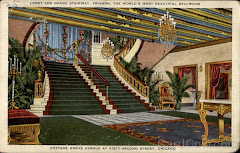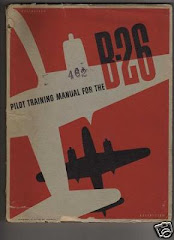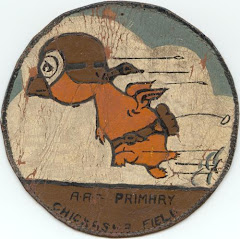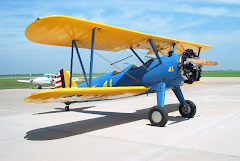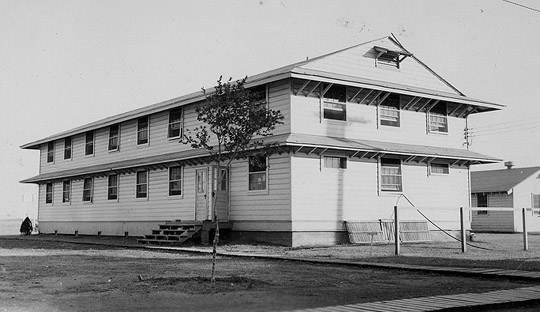Finally in late May of ’42 it was time to graduate and get those coveted Silver Wings.
The graduation was held in the base theater at ten in the morning. My folks and my oldest sister came down from Nebraska and my oldest brother, the one that I’d worked for on the ranch, and his wife came. My other brother and his family, that ones that I’d lived with when I was working on the cotton inspection team, had been transferred to a small community in southern Illinois where he was managing a pipeline station. The closest large town to them was Terre Haute, Indiana. Later, that had a big part to play in my life.
Our Graduation was as impressive as any ceremony I’ve ever attended since. The pomp and circumstance started and ended with marching of course. It’s hard to explain the thrill of being in uniform and marching in cadence while singing an inspiring song like the Army Air Corp anthem or the National anthem. It made your chest swell up with pride. I couldn’t carry a tune but luckily I was drowned out by a corps that could, and I felt like million as I sang at full volume and strode into the hall. We took an oath to our country and listened to a couple of speeches which congratulated us on surviving the most demanding training course in the military. The Brigadier General told us that so far over 40% of the cadets who entered flight training had washed out before graduating.
Next came the moment we anticipated, the presentation of the Silver Wings by the Lieutenant Colonel R. C. McBride. At the same time, we were promoted to 2nd Lieutenant, received our gold bars and a big dose of pride and excitement. In addition to the wings and the bars we also got a packet of “calling cards” with our name and rank: Lieutenant Air Corps, which we promptly exchanged with the other guys in our class and gave to our families. There was another benefit that we (and our families) appreciated and that was our new pay scale. We were now going to make $1,800 a year, plus we were entitled to a 50% bonus for flight pay!
It was a tradition when you received your Silver Wings that the first person that had to salute you, had to give you a dollar! That was a lot of money in 1942 when a bottle of cola was 5 cents and the daily newspaper cost 3 cents. Usually it was one of the lower classmen. I was so excited I have no memory of who had to give me my dollar.
Saturday, July 31, 2010
Sunday, August 9, 2009
Chapter 14 Advanced Flight School - Pampa Texas
After a week’s leave and a Greyhound bus ride to the panhandle of Texas about 40 miles northeast of Amarillo, where the Pampa Army Airfield was located, we started Advanced Flight School. It was February 1943 and the weather was often cold and sometimes stormy. The skies were generally clear with big cumulus clouds and fierce air currents. We appreciated the special uniforms, boots and gloves to help keep us warm when we were in the air, where it was many degrees colder than the Panhandle.
Although the airfield was similar to the one at Enid in terms of runways, hangers, control tower and water tower, the living accommodations were nothing like the nice two story barracks we’d had at Enid. We were now living in what might be termed a tar paper shack. Luckily we were there to learn to fly, and as far as accommodations we were all in the same boat, as always.
Now we were learning how to maneuver twin engine planes. They were faster, more complex, less forgiving and definitely more challenging. We had to learn how to handle the new power and speed. All the courses we’d learned in basic were geared for these bigger, more powerful planes. Meteorology and Navigation were delved into deeper here. And, we finally learned how to shoot those guns we’d been marching with. There was a skeet shooting range on the base and some of the guys had to spend a lot more time there than I did because of my pheasant hunting days. We were still doing calisthenics, obstacle courses and weightlifting. I had always been strong from my farming days but I was now feeling like quite the athlete.
We had about 12 hours of flying with the instructor before we did our daytime solo and around 25 for our nighttime solo. We practiced takeoffs and landings over and over, probably doing 80 or 90 during our training, most of them at night. Most flying was now done by instruments. There were six students per instructor in our class. Our instructor got our group checked out in an AT-9. Most of the instructors thought the AT-9s were too hot for students and kept them flying the AT-17s but we loved the 9s and had a ball with them. This is when we learned to love to fly.
Although the airfield was similar to the one at Enid in terms of runways, hangers, control tower and water tower, the living accommodations were nothing like the nice two story barracks we’d had at Enid. We were now living in what might be termed a tar paper shack. Luckily we were there to learn to fly, and as far as accommodations we were all in the same boat, as always.
Now we were learning how to maneuver twin engine planes. They were faster, more complex, less forgiving and definitely more challenging. We had to learn how to handle the new power and speed. All the courses we’d learned in basic were geared for these bigger, more powerful planes. Meteorology and Navigation were delved into deeper here. And, we finally learned how to shoot those guns we’d been marching with. There was a skeet shooting range on the base and some of the guys had to spend a lot more time there than I did because of my pheasant hunting days. We were still doing calisthenics, obstacle courses and weightlifting. I had always been strong from my farming days but I was now feeling like quite the athlete.
We had about 12 hours of flying with the instructor before we did our daytime solo and around 25 for our nighttime solo. We practiced takeoffs and landings over and over, probably doing 80 or 90 during our training, most of them at night. Most flying was now done by instruments. There were six students per instructor in our class. Our instructor got our group checked out in an AT-9. Most of the instructors thought the AT-9s were too hot for students and kept them flying the AT-17s but we loved the 9s and had a ball with them. This is when we learned to love to fly.
Saturday, July 18, 2009
Chapter 13 Basic Flight Training -2 Enid, Oklahoma
Officially, we were doing our basic pilot training at the US Army Air Force Flying School in Enid, Oklahoma. We were Aviation Cadets. We were still on a fast and tight training schedule at Basic because the war needed pilots. Civilian manufacturers were building planes as fast as they could and the Army Air Force was training the men to fly them. Up until December ’42, when voluntary enlistments were terminated, the Army Air Force had been a volunteer organization. Then, if you were drafted into the Army, you could apply for enlistment in the Air Force but the Air Force recruiters skimmed “the best of the best” men from the Army for their program – and they told us about the rigorous selection because it meant we were surrounded by men of caliber. They were building our confidence, attitude and pride.
Things were a little less stressful at Enid because we knew we’d made the cut. Almost half the guys that started were gone, but we hadn’t washed out. Physical training was still a big part of our daily regimen. We marched to classes and infantry drill singing the Air Corps song, “Off we go into the wild blue yonder…”. We became part of a coordinated team.
Flight training in basic involved a lot of navigation, instrument flying, night flying, cross country flying, and formation flying. Learning how to do all these maneuvers involved both actual flight experience and learning in flight simulators called Link Trainers. Link Trainers were used mostly for learning instrument flying.
Formation flying was a challenge for most of us. You had to tuck your wing right behind the instructor’s wing and stay in exactly that position. It was easy if he was flying level and going straight ahead. It was still pretty easy to stay in position through speed increases and decreases. Soon there were turns, then climbing turns and even loops. We practiced over and over, the instructor constantly stressing the importance of formation flying. It seemed like that’s all we would be doing. Later, when we were in combat we’d be thankful for those stringent exercises.
Night flying was another challenge that required learning to go over and over the flight details from weather to headings to checkpoints. Every morning went to ground school learning how to navigate, studying plane engines and systems, practicing Morse Code. We learned radio procedures and theory of flight.
Finally, after weeks of practice we got to the end of Basic Training and were waiting our assignments to the next phase of training. Assignments were finally posted. I would be going to multi-engine advanced flight training in Pampa, Texas! Our graduation was celebrated at a Stag Dinner held in the cadet mess hall, but we didn’t eat out of our mess kits that night.
Things were a little less stressful at Enid because we knew we’d made the cut. Almost half the guys that started were gone, but we hadn’t washed out. Physical training was still a big part of our daily regimen. We marched to classes and infantry drill singing the Air Corps song, “Off we go into the wild blue yonder…”. We became part of a coordinated team.
Flight training in basic involved a lot of navigation, instrument flying, night flying, cross country flying, and formation flying. Learning how to do all these maneuvers involved both actual flight experience and learning in flight simulators called Link Trainers. Link Trainers were used mostly for learning instrument flying.
Formation flying was a challenge for most of us. You had to tuck your wing right behind the instructor’s wing and stay in exactly that position. It was easy if he was flying level and going straight ahead. It was still pretty easy to stay in position through speed increases and decreases. Soon there were turns, then climbing turns and even loops. We practiced over and over, the instructor constantly stressing the importance of formation flying. It seemed like that’s all we would be doing. Later, when we were in combat we’d be thankful for those stringent exercises.
Night flying was another challenge that required learning to go over and over the flight details from weather to headings to checkpoints. Every morning went to ground school learning how to navigate, studying plane engines and systems, practicing Morse Code. We learned radio procedures and theory of flight.
Finally, after weeks of practice we got to the end of Basic Training and were waiting our assignments to the next phase of training. Assignments were finally posted. I would be going to multi-engine advanced flight training in Pampa, Texas! Our graduation was celebrated at a Stag Dinner held in the cadet mess hall, but we didn’t eat out of our mess kits that night.
Thursday, May 14, 2009
Chapter 12 Accessories Instill Pride
Now that we were in basic training at Enid we could relax a little. We were told that over 40% of our class had "washed out," but we'd made the grade. The Army was going to instill us with pride and convince us we were the best they had. They heaped praise on us for making it to this stage of training, calling us "the cream of the crop" and telling us we had the right to be proud. We kept marching to classes in cadence singing inspirational songs. We were told we were going to be the "best trained air-force in the world." The silver wings helped a lot.
 |
| Coveted Silver Wings of Cadets |
 |
| Cadet Insignia on Patch |
Thursday, April 23, 2009
Chapter 12 The Magnificent Flying Machines
At Enid we got about 50 hours of training in the TB25 also known as the AT-24. No more open cockpit, 2 seater planes for us, this was an exciting plane! They ones we had were 2 engine, dual controls that could hold a 3-5 man crew. The nose of the plane was what they called the "greenhouse" made of plexi-glass to give the bombardiers as good a view of their target as possible. Of course we didn't have any crew we were still learning to fly.
Thursday, April 2, 2009
Saturday, March 21, 2009
Chapter 12 Basic Flight Training, Enid OK
Enid Oklahoma was about 100 miles north of Chickasha. After a couple days leave we were loaded on a bus that traveled straight north on U.S. Highway 81 to Enid. We arrived about a year after it was first constructed. The barracks were two story frame buildings that looked like very large houses. There was the usual parade ground and of course hangers and runways. Built as a temporary base, the main feature was a huge water tower roughly in the center of the base.
One of the first things they did at Enid was issue rifles. We had to clean and assemble them and be able to take them apart and put them back together. For an old pheasant hunter like me it was second nature but many of the guys had never seen a gun before. Surprisingly, we weren’t taught to shoot the rifles, we just had to know how to assemble them and carry them in marches and parades.
They were very strict about us keeping orderly quarters. The term “white glove inspections” came from military inspections. The officer would put on a white glove and run his finger across every surface in the barracks. If any dust accumulated on the glove or discolored it, demerits were handed out. When you accumulated demerits over the maximum allowed you had to “walk them off” on the parade grounds on Saturdays. It was usually one hour of walking for each demerit over the limit.
Day to day classes at Enid continued, much like at the previous two bases, with the usual physical fitness drills, obstacle course, close order drills, marches, and lecture classes on military indoctrination, common courtesy, math, weather, navigation and specialty classes on airplane instruments, airplane recognition and airplane mechanics.
After about 70 hours of flying and daily classroom training, we were assigned to the TB25 airplane, also known as the AT-24. They were dual control, 2 engine bomber planes that flew with a 5 man crew. They had a top speed of over 300 miles per hour.
By the end of Basic they would decide who would be fighter pilots and who would be bomber pilots. Of course we all wanted to be fighter pilots, that’s why we practiced our aerial acrobatics every chance we got. They determined the assignments by instructor recommendations, tests they gave us, performance in class and what they needed most at the time.
One of the first things they did at Enid was issue rifles. We had to clean and assemble them and be able to take them apart and put them back together. For an old pheasant hunter like me it was second nature but many of the guys had never seen a gun before. Surprisingly, we weren’t taught to shoot the rifles, we just had to know how to assemble them and carry them in marches and parades.
They were very strict about us keeping orderly quarters. The term “white glove inspections” came from military inspections. The officer would put on a white glove and run his finger across every surface in the barracks. If any dust accumulated on the glove or discolored it, demerits were handed out. When you accumulated demerits over the maximum allowed you had to “walk them off” on the parade grounds on Saturdays. It was usually one hour of walking for each demerit over the limit.
Day to day classes at Enid continued, much like at the previous two bases, with the usual physical fitness drills, obstacle course, close order drills, marches, and lecture classes on military indoctrination, common courtesy, math, weather, navigation and specialty classes on airplane instruments, airplane recognition and airplane mechanics.
After about 70 hours of flying and daily classroom training, we were assigned to the TB25 airplane, also known as the AT-24. They were dual control, 2 engine bomber planes that flew with a 5 man crew. They had a top speed of over 300 miles per hour.
By the end of Basic they would decide who would be fighter pilots and who would be bomber pilots. Of course we all wanted to be fighter pilots, that’s why we practiced our aerial acrobatics every chance we got. They determined the assignments by instructor recommendations, tests they gave us, performance in class and what they needed most at the time.
Subscribe to:
Posts (Atom)








